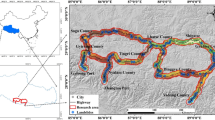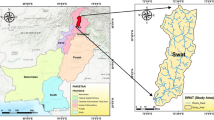Abstract
Earthquake-induced landslides are difficult to assess and predict owing to the inherent unpredictability of earthquakes. In most existing studies, the landslide potential is statistically assessed by collecting and analyzing the data of historical landslide events and earthquake observation records. Unlike rainfall-induced landslides, earthquake-induced landslides cannot be predicted in advance using real-time monitoring systems, and the development of the models for these landslides should instead depend on early earthquake warnings and estimations. Hence, in this study, factor analysis was performed and the frequency distribution method was employed to investigate the potential risk of the landslides caused by earthquakes. Factors such as the slope gradient, lithology (geology), aspect, and elevation were selected and classified as influential factors to facilitate the construction of a landslide database for the area of study.
Similar content being viewed by others
References
Bai X P, Liu Y N. Reliability analysis on civil engineering project based on integrated adaptive simulation annealing and gray correlation method. Frontiers of Structural and Civil Engineering, 2016, 10(4): 462–471
Sun L, Chen J, Li T. A MODIS-based method for detecting large-scale vegetation disturbance due to natural hazards: A case study of Wenchuan earthquake stricken regions in China. Stochastic Environmental Research and Risk Assessment, 2016, 30(8): 2243–2254
Takabatake H, Matsuoka M. Origin of the anomalously large upward acceleration associated with the 2008 Iwate-Miyagi Nairiku earthquake. Earthquakes and Structures, 2012, 3(5): 675–694
Torizin J. Elimination of informational redundancy in the weight of evidence method: An application to landslide susceptibility assessment. Stochastic Environmental Research and Risk Assessment, 2016, 30(2): 635–651
Ho K K S, Cheung R W M, Wong C Y S. Managing landslide risk systematically using engineering works. Proceedings of the Institution of Civil Engineers-Civil Engineering, 2016, 169(6): 25–34
Rabczuk T, Areias P M A. A new approach for modelling slip lines in geological materials with cohesive models. International Journal for Numerical and Analytical Methods in Geomechanics, 2006, 30(11): 1159–1172
Wu W, Zhuang X, Zhu H, Liu X, Ma G. Centroid sliding pyramid method for removability and stability analysis of fractured hard rock. Acta Geotechnica, 2017, 12(3): 627–644
Zheng W, Zhuang X, Tannant D D, Cai Y, Nunoo S. Unified continuum/discontinuum modeling framework for slope stability assessment. Engineering Geology, 2014, 179: 90–101
Crosta G B, Imposimato S, Roddeman D G. Numerical modelling of large landslides stability and runout. Natural Hazards and Earth System Sciences, 2003, 3(6): 523–538
Di B, Stamatopoulos C A, Dandoulaki M, Stavrogiannopoulou E, Zhang M, Bampina P. A method predicting the earthquake-induced landslide risk by back analyses of past landslides and its application in the region of the Wenchuan 12/5/2008 earthquake. Natural Hazards, 2017, 85(2): 903–927
Fathani T F. The analysis of earthquake-induced landslides with a three-dimensional numerical model. In: Proceedings of Geotechnics symposium. Yogyakarta: Gajah Mada University, 2006, 159–165
McDougall S, Hungr O. A model for the analysis of rapid landslide motion across three-dimensional terrain. Canadian Geotechnical Journal, 2004, 41(6): 1084–1097
Pastor M, Haddad B, Sorbino G, Cuomo S, Drempetic V. A depth-integrated coupled SPH model for flow-like landslides and related phenomena. International Journal for Numerical and Analytical Methods in Geomechanics, 2009, 33(2): 143–172
Stamatopoulos C, Di B. Analytical and approximate expressions predicting post-failure landslide displacement using the multi-block model and energy methods. Landslides, 2015, 12(6): 1207–1213
Li Y J. Development of earthquake-induced landslide fragility curves using an empirical statistical model. Thesis for the Master’s Degree. Taichung, China: Feng Chia University, 2016
Liao H W. Landslides triggered by Chi-Chi Earthquake. Thesis for the Master’s Degree. Taoyuan, China: Central University, 2000
Wang W N, Yin C Y, Chen Z Q, Li M Q. The current situation of landslide areas in the 921 earthquake and disaster prevention. In: Proceedings of the Sino-Japan Sediment Disaster Investigation and Management Symposium after the 921 Earthquake. Nantou: Soil and Water Conservation Bureau, 2000, 79–90
Wen C Y. A landslide model analysis with combining factors of earthquake and typhoon. Thesis for the Master’s Degree. Tainan, China: Cheng Kung University, 2005
Barredo J I, Benavides A, Hervas J, van Westen C J. Comparing heuristic landslide hazard assessment techniques using GIS in the Tirajana basin, Gran Canaria Island, Spain. International Journal of Applied Earth Observations & Geoinformation, 2000, 2(1): 9–23
Lee C F, Li J, Xu Z W, Dai F C. Assessment of landslide susceptibility on the natural terrain of Lantau Island, Hong Kong. Environmental Geology, 2001, 40(3): 381–391
Lee S R, Chwae U, Min K. Landslide susceptibility mapping by correlation between topography and geological structure: The Janghung area, Korea. Geomorphology, 2002, 46(3-4): 149–162
Lin Y H. Application of neural network to landslide susceptibility analysis. Thesis for the Master’s Degree. Taoyuan, China: Central University, 2003
Ercanoglu M, Gokceoglu C, van Asch Th W J. Landslide susceptibility zoning north of Yenice (NW Turkey) by multivariate statistical techniques. Natural Hazards, 2004, 32(1): 1–23
Süzen M L, Doyuran V. A comparison of the GIS based landslide susceptibility assessment methods: Multivariate versus bivariate. Environmental Geology, 2004, 45(5): 665–679
Gómez H, Kavzoglu T. Assessment of shallow landslide susceptibility using artificial neural networks in Jabonosa River Basin, Venezuela. Engineering Geology, 2005, 78(1-2): 11–27
Feng Z X. Assessment of vegetation recovery for earthquake-induced landslides at the Chiufanershan Area. Thesis for the Master’s Degree. Changhua, China: Ming Dao University, 2007
Chen Y S. An influence of earthquake on the occurrence of landslide and debris flow. Dissertation for the Doctoral Degree. Tainan, China: Cheng Kung University, 2008
Chen C H. A study of the occurrence of landslides after the Chi-Chi Earthquake in the Lao-Nong River Watershed. Thesis for the Master’s Degree. Tainan, China: Cheng Kung University, 2009
Lee S T. The analysis of potential in heavy rainfall-induced landslides affected by the attenuation pattern of ground disturbing after a major seismic event. Dissertation for the Doctoral Degree. Tainan, China: Cheng Kung University, 2010
Liu Y S. Characteristics and spatial differences of debris flow and landslide occurrences in the Headstreams of Chenyoulan River: With the Hoshe Basin as an example. Dissertation for the Doctoral Degree. Taipei, China: Taiwan Normal University, 2014
Liang W Z, Zhao G Y, Wu H. Evaluating investment risks of metallic mines using an extended TOPSIS method with linguistic neutrosophic numbers. Symmetry, 2017, 9(8): 149
Chiu H Y, Bih H D, Liou M, Yang K S. Research methods on social and behavior science: Data analysis. Taipei, China: Tung Hua Book Co. Ltd., 2015
Acknowledgements
The work described in this paper was a part of the research sponsored by the Ministry of Science and Technology, Taiwan, China (Contract No. MOST 105-2221-E-035-074) and Soil and Water Conservation Bureau, Taiwan, China (Contract No. SWCB-106-055).
Author information
Authors and Affiliations
Corresponding author
Rights and permissions
About this article
Cite this article
Lin, JW., Hsieh, MH. & Li, YJ. Factor analysis for the statistical modeling of earthquake-induced landslides. Front. Struct. Civ. Eng. 14, 123–126 (2020). https://doi.org/10.1007/s11709-019-0582-y
Received:
Accepted:
Published:
Issue Date:
DOI: https://doi.org/10.1007/s11709-019-0582-y




